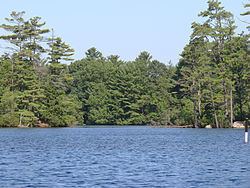Basin countries United States Max. width 1.1 mi (1.8 km) Area 3.169 km² Mean depth 2.7 m | Max. length 3.5 mi (5.6 km) Surface area 784 acres (3.17 km) Surface elevation 76 m Length 5.6 km | |
 | ||
Primary inflows Similar Pawtuckaway State Park, Suncook Lakes, Pleasant Lake, Powwow Pond, Swains Lake | ||
Pawtuckaway lake trip
Pawtuckaway Lake is a 784-acre (3.17 km2) water body located in Rockingham County in southeastern New Hampshire, United States, in the town of Nottingham. The official name of the lake is Pawtuckaway Pond. The original, natural pond was enlarged in the 19th century by the construction of four dams. Three of the dams, near the southern end of the lake, feed the Pawtuckaway River, which flows southeast to the Lamprey River in the western part of the town of Epping. The fourth dam, located at the north end of the lake, releases water to the Bean River, leading to the North River and ultimately the Lamprey River in the northern part of Epping. The lake is located in the Piscataqua River drainage basin.
Contents
- Pawtuckaway lake trip
- Map of Pawtuckaway Lake Nottingham NH 03290 USA
- NameEdit
- HistoryEdit
- GeographyEdit
- FisheryEdit
- References
Map of Pawtuckaway Lake, Nottingham, NH 03290, USA
Approximately half of the lake's shoreline consists of private homes, a mixture of seasonal and year-round residents. Most of the western side of Pawtuckaway Lake is occupied by Pawtuckaway State Park, a popular camping, swimming, hiking and orienteering destination. Canoe orienteering events are held on the lake.
NameEdit
The original pond was called Pawtuckaway Pond, and the name stayed after it was enlarged. According to the U.S. Board on Geographic Names, this is still its official name, and anything that uses federal data also uses that name. However, it is usually referred to as Pawtuckaway Lake by residents and organizations, even by Pawtuckaway State Park.
HistoryEdit
Pawtuckaway Lake was partially created due to industrial expansion in nearby Newmarket in the early 19th century. The area was originally composed of many brooks, which sometimes collected in low spots and formed ponds, such as what was then known as Pawtuckaway Pond. Some of the brooks that ran through the area eventually ran into the Pawtuckaway River. Both the North River and the Pawtuckaway River then ran into the Lamprey River, which created water power for the Newmarket Manufacturing Company, a textile mill. This company, possibly thinking that the water supply was not enough for their needs, came to the area and started to purchase land for a dam and some flooding rights. Two dams were completed around 1836, creating two artificial ponds, one of which was a larger Pawtuckaway Pond. These dams, along with several dikes built to stop the flooding of land that was not purchased, eventually created today's Pawtuckaway Lake.
GeographyEdit
The lake contains many shallow parts where rocks can be seen, even in the middle of the lake. It also contains countless small islets, ranging from small rocks protruding from the water to islands large enough to walk around on. These numerous small features make the lake attractive for canoe orienteering. The land mostly surrounded by the lake is Big Island, which is considered to be an island because of the marshland to the west of it. The southern portion of Big Island makes up about half of the campsites in Pawtuckaway State Park. The other sites are located on Horse Island and near Neal's Cove. Horse Island, named so because of its shape, is the second largest island in Pawtuckaway Lake after Big Island. Swimming is not allowed off shorelines in the state park except at a beach area that has a roped-off section for swimming, picnic areas, and a spot to launch canoes and kayaks.
FisheryEdit
The lake is classified as a warmwater fishery, with observed species including smallmouth and largemouth bass, chain pickerel, white perch, horned pout, and black crappie.
